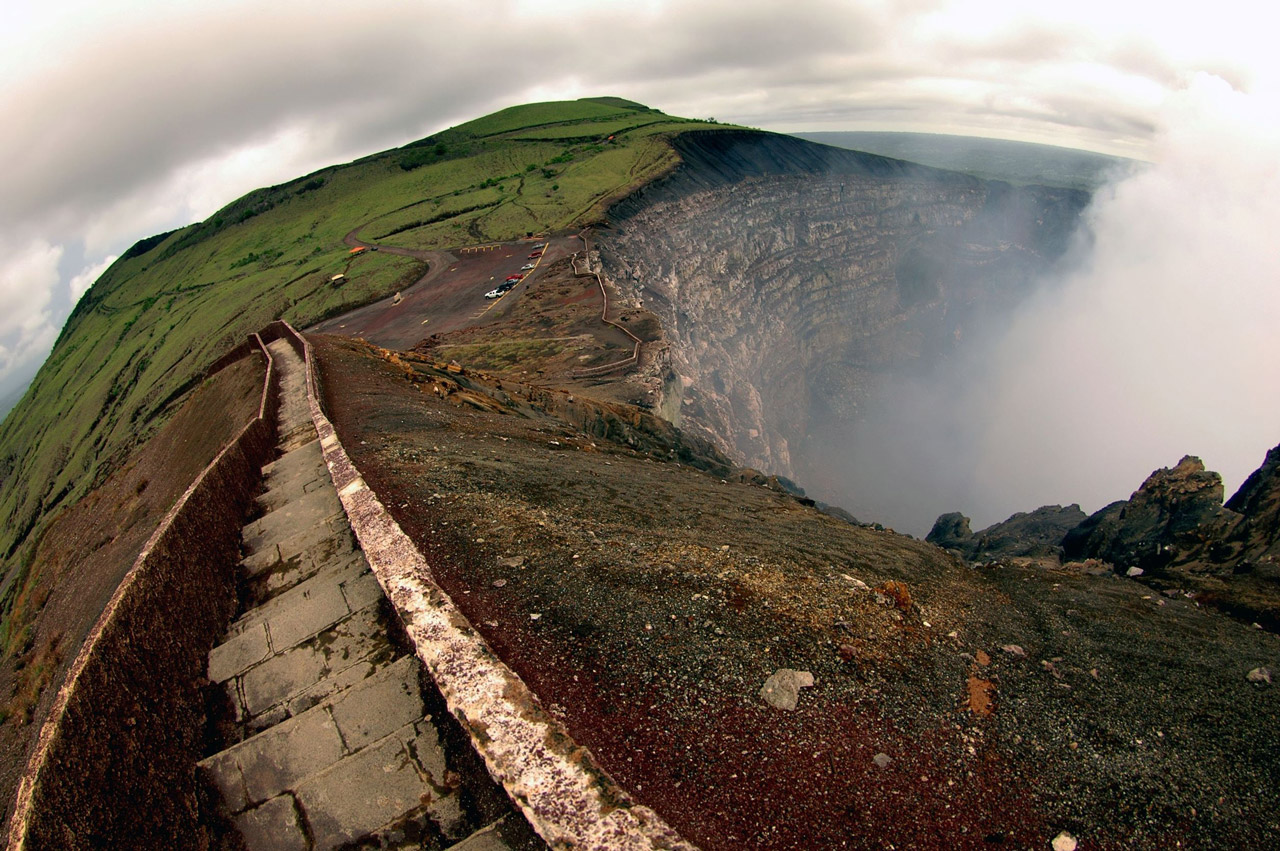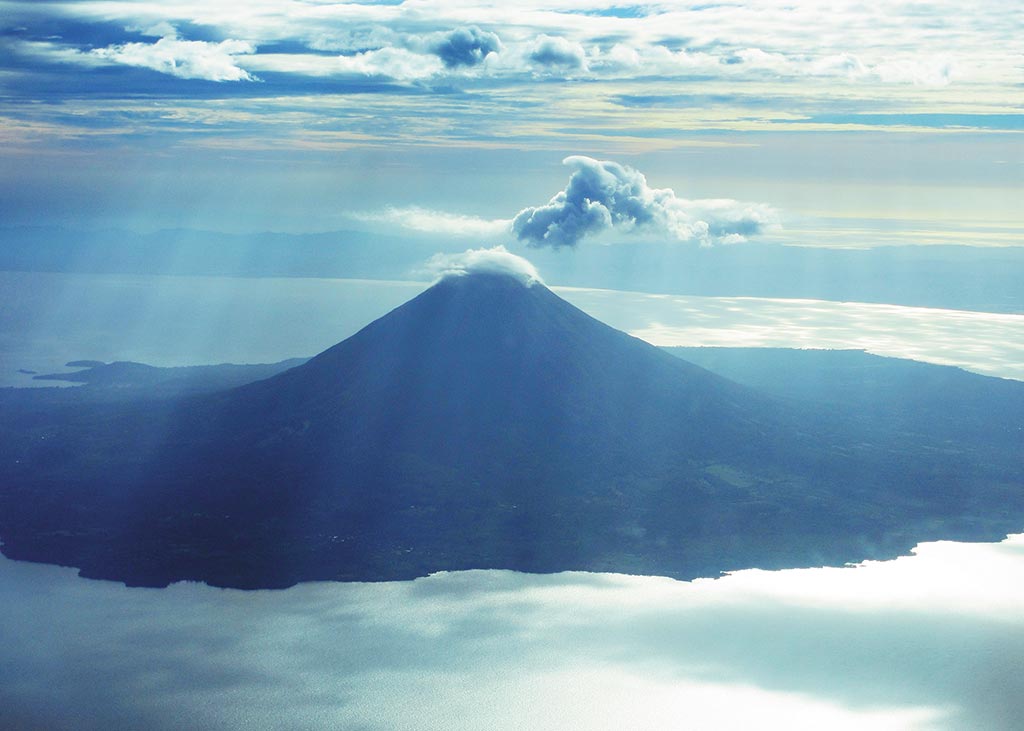The largest and lowest Central American country, Nicaragua is a nation of geographical superlatives. Located at the elbow where the Central American isthmus bends and then plummets southward to Panamá, Nicaragua is almost dead center between North and South America and is approximately the size of Greece or New York State.
Convergence of the plates ensures crustal instability, which manifests itself in frequent volcanic and earthquake activity in all of Central America, and especially in Nicaragua. Usually, earthquakes are so small they go unnoticed. In April 2014, consistent earthquakes over the course of a week led to serious damage in many homes in Nagarote, as well as permanent damage to several structures in Managua, including the large amphitheater in La Plaza de la Fe that once dominated Managua’s waterfront.

At the edge of Volcán Masaya’s crater. Photo © Andrea Santini/123rf.
Nicaragua has about 40 volcanoes, a half dozen of which are usually active at any time. Running parallel to the Pacific shore, Nicaragua’s volcanoes are a part of the Ring of Fire that encompasses most of the western coast of the Americas, the Aleutian Islands of Alaska, Japan, and Indonesia. The Maribio (Nahuatl for the “giant men”) and Dirian volcano ranges stretch nearly 300 kilometers from Concepción and Maderas in the middle of Lake Cocibolca to Cosigüina, which juts into the Gulf of Fonseca.
The first volcanic event in recorded history was a major eruption of Volcán Masaya in the early 1500s. The lava formed the present-day lagoon at the base of the mountain. Another great lava flow occurred in 1772, leaving a black, barren path still visible today where the Carretera Masaya highway crosses it. In 1609, Spanish settlers abandoned the city of León when Momotombo erupted. In January 1835, Volcán Cosigüina violently blew its top, hurling ash as far away as Jamaica and Mexico, covering the area for 250 kilometers around the volcano in ash and burning pumice and forcing the entire peninsula into three days of darkness. All this volcanic activity is responsible for the exceptional fertility of Nicaragua’s soils, most notably the agricultural plains around Chinandega and León.
Volcán Masaya is the most easily accessed of Nicaragua’s volcanoes and boasts a paved road leading right to the lip of the crater. Volcán Masaya is actually formed of three craters, the largest of which, Santiago, is the only crater in the Americas that contains a visible pool of incandescent liquid lava in its center. The visibility of this lava fluctuates on a 30-year cycle.
Climbing a few Nicaraguan giants is a great way to experience Central America. San Cristóbal is the highest peak, at 1,745 meters. A smaller peak adjacent to San Cristóbal, Volcán Casita still bears the immense scar of the landslide that buried thousands in an avalanche of rock and mud during Hurricane Mitch and trembled briefly again in January 2002. Isla de Ometepe’s twin cones are popular for hiking and easily accessible. No matter where you hike, always hire a guide, as several foreigners have gotten lost and perished while peak bagging.

Volcán Maderas is a pleasant volcano to climb. Photo © Elizabeth Perkins.
Momotombo, San Cristóbal, and Telica are the most active peaks and are prone to emit plumes of poisonous gases, smoke, and occasionally lava. La Isla de Ometepe’s Volcán Concepción (1,610 meters) last blew its top in 2009 and 2012. The other half of Ometepe (Nahuatl for “two peaks”) is Volcán Maderas (1,394 meters), which sleeps, its crater drowned in a deep lagoon that feeds a thriving jungle.
Volcán Telica, just north of León, erupts approximately every five years, while gas vents at its base churn out boiling mud and sulfur. Neighboring Cerro Negro is one of the youngest volcanoes on the planet: It protruded through a farmer’s field in the middle of the 1800s and has since grown in size, steadily and violently, to a height of 400 meters. Cerro Negro’s last three eruptions have been increasingly powerful, culminating in 1992 when it belched up a cloud of burning gases and ash seven kilometers high, burying León under 15 centimeters of ash and dust. Eight thousand inhabitants were evacuated as the weight of the ash caused several homes to collapse. Volcán Momotombo’s (Nahuatl for “great burning peak”) perfect conical peak is visible from great distances across the Pacific plains, as far away as Matagalpa. Momotombo is responsible for approximately 10 percent of Nicaragua’s electricity via a geothermal plant located at its base. It hasn’t erupted since 1905, but Momotombo remains a monster whose menace is taken quite seriously. In April 2000 it rumbled long enough to get Managua’s attention, then quieted back down.
A popular day trip from Granada is the cloud forest park and coffee plantations of Volcán Mombacho (1,345 meters), a dormant volcano whose explosion and self-destruction formed the archipelago of isletas in Lake Cocibolca. Mombacho took its modern shape in 1570 when a major avalanche on the south slope opened and exposed the crater, burying an indigenous village of 400 inhabitants in the process.
Excerpted from the Sixth Edition of Moon Nicaragua.